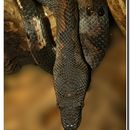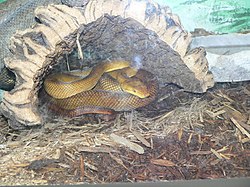tr
kırıntılardaki isimler


Die Pazifik-Boas (Candoia) sind eine Gattung der Boaartigen, die mit fünf Arten Inseln im Südpazifischen Ozean, von Sulawesi über Papua-Neuguinea, und Melanesien bis Samoa und den Palauinseln besiedelt. Diese kommen gebietsweise sympatrisch, d. h. zusammen im gleichen Gebiet, oder zusammen mit einigen Python-Arten vor. In solchen Fällen nehmen die verschiedenen Arten jeweils unterschiedliche ökologische Nischen ein.
Pazifik-Boas sind kleine bis mittelgroße Riesenschlangen mit Körperlängen von 60 cm bis etwa einem Meter, bei der Pazifik-Baumboa gelegentlich auch fast zwei Meter. Sie weisen gekielte Schuppen und ein abgewinkeltes Rostralschild auf, was die Schnauze bei seitlicher Ansicht stark zugespitzt erscheinen lässt. Der Kopf ist dreieckig und deutlich vom Hals abgesetzt. Die Männchen weisen verlängerte Aftersporne auf. Sämtliche Arten sind wie alle Boas mit Ausnahme des Erdpythons lebendgebärend.
Die Gattung Candoia wurde 1842 durch den britischen Zoologen John Edward Gray beschrieben. Bis vor kurzem wurde sie der Unterfamilie der Boaschlangen (Boinae) zugeordnet, 2013 aber durch Robert Alexander Pyron und Kollegen in die neu aufgestellte Unterfamilie Candoiinae gestellt, da sie einer molekulargenetischen Analyse zufolge die Schwestergruppe einer Klade von Boaschlangen (Boinae) und Sandboas (Erycidae) ist.[1]
Alle Arten der Pazifik-Boas sind in den Anhang II des Washingtoner Artenschutzabkommens aufgenommen[2]. Das heißt, dass der Im- und Export von Tieren genehmigt werden muss. Ferner müssen Tiere, die sich in privater Haltung befinden, bei der zuständigen Behörde (Gemeinde und Untere Naturschutzbehörde) angemeldet sein.
Die Pazifik-Boas (Candoia) sind eine Gattung der Boaartigen, die mit fünf Arten Inseln im Südpazifischen Ozean, von Sulawesi über Papua-Neuguinea, und Melanesien bis Samoa und den Palauinseln besiedelt. Diese kommen gebietsweise sympatrisch, d. h. zusammen im gleichen Gebiet, oder zusammen mit einigen Python-Arten vor. In solchen Fällen nehmen die verschiedenen Arten jeweils unterschiedliche ökologische Nischen ein.
Candoia is a genus of non-venomous boas found mostly in New Guinea, Melanesia and the Maluku Islands in Indonesia. Common names include bevel-nosed boas and keel-scaled boas.[2]
The species of the genus Candoia typically have a rounded and heavy body, with a flattened triangular-shaped head and an upturned nose. Colors and patterns vary greatly, but most are various shades of brown to black. Species can vary in adult size from 60 cm (24 in) to 1.8 m (5.9 ft) in total length (including the tail). Males are typically smaller than females and can be distinguished by their prominent cloacal spurs.
The species of the genus Candoia are found from Samoa and Tokelau west through Melanesia to New Guinea and the Maluku Islands in indonesia.[1]
All species of Candoia are primarily nocturnal.
The primary diet of Candoia species consists of frogs and lizards.
In the species of the genus Candoia, breeding occurs early in the year, typically after rains. Several males will approach and pursue a single female, though, there is no combat between the males. Females seem to only ovulate once every two or three years and give birth to litters averaging 10 or so neonates. The Solomon Island ground boa (C. paulsoni) is an exception, as it is known to have particularly large litters, occasionally producing 30 or 40 small neonates.
The species of the genus Candoia are frequently imported for the exotic pet trade, but are now being bred in captivity with some regularity by private individuals. Their small size and ease of care make them interesting captives, but wild-caught specimens are not known to acclimate well. The stress of captivity manifests itself in the form of lack of interest in food. Their natural diet often presents a problem for hobbyists mainly familiar with using rodents as food.
Five species are recognized:[2]
Species[2] Taxon author[2] Subspecies*[2] Common name[3] Geographic range[1] C. aspera (Günther, 1877) 0 Papuan ground boa, New Guinea ground boa, viper boa New Guinea (Irian Jaya and Papua New Guinea below 1,300 m), including the nearby islands of Waigeu, Batanta, Misool and Salawati, the islands of Biak and Yapen in Geelvink Bay, Seleo, Valise, Karkar, Umboi, Manus, Los Negros, Lou, Baluan, the Rambatyo Islands in the Manus Group (the Admiralty Islands), New Britain, Duke of York, New Ireland and New Hanover in the Bismarck Archipelago. C. bibroni
(Günther, 1877) 0 Papuan ground boa, New Guinea ground boa, viper boa New Guinea (Irian Jaya and Papua New Guinea below 1,300 m), including the nearby islands of Waigeu, Batanta, Misool and Salawati, the islands of Biak and Yapen in Geelvink Bay, Seleo, Valise, Karkar, Umboi, Manus, Los Negros, Lou, Baluan, the Rambatyo Islands in the Manus Group (the Admiralty Islands), New Britain, Duke of York, New Ireland and New Hanover in the Bismarck Archipelago. C. bibroni (A.M.C. Duméril & Bibron, 1844) 1 Bibron's bevel-nosed boa, Bibron's keel-scaled boa, Pacific tree boa, Fiji boa Melanesia and Polynesia, including the eastern Solomon Islands (Olu Malau, the Reef Islands, Rennell Island, San Critobal, Santa Ana Island, the Santa Cruz Islands, Bio, Bellona Island, Three Sisters, Ugi Island and the Vanikolo Islands), the Banks Islands (Vanua Lava Island), the New Hebrides, all three of the Loyalty Islands, the Fiji Islands (Rotuma, the Yasawa Group and the Lau Group), Western Samoa (Savai'i and Upolu) and American Samoa (Taʻū). C. carinata
(A.M.C. Duméril & Bibron, 1844) 1 Bibron's bevel-nosed boa, Bibron's keel-scaled boa, Pacific tree boa, Fiji boa Melanesia and Polynesia, including the eastern Solomon Islands (Olu Malau, the Reef Islands, Rennell Island, San Critobal, Santa Ana Island, the Santa Cruz Islands, Bio, Bellona Island, Three Sisters, Ugi Island and the Vanikolo Islands), the Banks Islands (Vanua Lava Island), the New Hebrides, all three of the Loyalty Islands, the Fiji Islands (Rotuma, the Yasawa Group and the Lau Group), Western Samoa (Savai'i and Upolu) and American Samoa (Taʻū). C. carinata (Schneider, 1801) 1 Pacific ground boa, Pacific keel-scaled boa, Indonesian tree boa Indonesia, including the northern peninsula of Sulawesi, the Sangihe and Telaud Islands, the northern Maluku Islands (Seram, Ambon, Haruku, Saparua, the Banda Islands, Goram and the Tanimbar Islands), Misool, Batanta, Salawatti, Anaguar (Saipan) and the Palau Group (at least on Koror Island). New Guinea: the islands of Geelvink Bay and those along the northern coast, including Liki, Djamna, Karkar and the Umboi Islands. Manus and nearby islands. The Bismarck Archipelago, including the islands of Mussau and Tench. The islands of Milne Bay Province, at least on Samarai, Kiriwina, Kitava, Goodenough, Fergusson, Dobu, Normanby, Slade, Misima, Woodlark, Sudest and Rossel. The islands of Buka, Bougainville Island and those nearby. The Solomon Islands, including Santa Cruz, Rennell and Bellona. C. paulsoni (Stull, 1956) 4 Solomon Islands ground boa Indonesia: Halmahera, the Talaud Islands. New Guinea. The Bismarck Archipelago. The Solomon Islands. C. superciliosa (Günther, 1863) 1 Palau bevel-nosed boa, Belau bevel-nosed boa[2] Palau[4]
(Schneider, 1801) 1 Pacific ground boa, Pacific keel-scaled boa, Indonesian tree boa Indonesia, including the northern peninsula of Sulawesi, the Sangihe and Telaud Islands, the northern Maluku Islands (Seram, Ambon, Haruku, Saparua, the Banda Islands, Goram and the Tanimbar Islands), Misool, Batanta, Salawatti, Anaguar (Saipan) and the Palau Group (at least on Koror Island). New Guinea: the islands of Geelvink Bay and those along the northern coast, including Liki, Djamna, Karkar and the Umboi Islands. Manus and nearby islands. The Bismarck Archipelago, including the islands of Mussau and Tench. The islands of Milne Bay Province, at least on Samarai, Kiriwina, Kitava, Goodenough, Fergusson, Dobu, Normanby, Slade, Misima, Woodlark, Sudest and Rossel. The islands of Buka, Bougainville Island and those nearby. The Solomon Islands, including Santa Cruz, Rennell and Bellona. C. paulsoni (Stull, 1956) 4 Solomon Islands ground boa Indonesia: Halmahera, the Talaud Islands. New Guinea. The Bismarck Archipelago. The Solomon Islands. C. superciliosa (Günther, 1863) 1 Palau bevel-nosed boa, Belau bevel-nosed boa[2] Palau[4] The genus Candoia is traditionally placed in the subfamily Boinae; however, a 2013 study comparing DNA sequences of 12 genes of over 4,000 species supported Candoia as more distantly related, with remaining members of the Boinae being more closely related to the boid subfamily Erycinae; thus Candoia was placed in the newly named subfamily Candoiinae.[5]
Candoia is a genus of non-venomous boas found mostly in New Guinea, Melanesia and the Maluku Islands in Indonesia. Common names include bevel-nosed boas and keel-scaled boas.
Candoia es el único género de serpientes constrictoras pertenecientes a la subfamilia Candoiinae, la cual pertenece a la familia Boidae. Este género incluye cinco especies y varias subespecies de pequeñas boas autóctonas de Nueva Guinea y algunas islas de la Melanesia y las Molucas. [1][2]
Candoia es el único género de serpientes constrictoras pertenecientes a la subfamilia Candoiinae, la cual pertenece a la familia Boidae. Este género incluye cinco especies y varias subespecies de pequeñas boas autóctonas de Nueva Guinea y algunas islas de la Melanesia y las Molucas.
Candoia on maoperekond. Nad on kägistajamaod.
Selles artiklis on kasutatud prantsuskeelset artiklit fr:Candoia seisuga 22.12.2013.
Candoia on maoperekond. Nad on kägistajamaod.
Candoia Boidae familiako narrasti genero bat da. Samoan, Polinesian eta Sulawesin aurki daitezke.
Candoia Boidae familiako narrasti genero bat da. Samoan, Polinesian eta Sulawesin aurki daitezke.
Candoia est un genre de serpents de la famille des Boidae[1].
Les espèces de ce genre se rencontrent des Samoa en Polynésie jusqu'à Sulawesi en Indonésie[1].
Ce sont des serpents principalement nocturnes. Ils ont un corps épais, avec une tête triangulaire et aplatie. Les couleurs varient selon les individus, mais les tons de brun et de noir reviennent souvent.
Ils peuvent atteindre de 60 à 180 centimètres, les mâles étant plus petits que les femelles. Ils se nourrissent de petits amphibiens et lézards.
La reproduction a lieu en début d'année, et les femelles donnent naissance à environ dix petits, à l'exception notable de C. carinata qui peut donner naissance à près de 40 petits.
Selon Reptarium Reptile Database (1 août 2011)[2] :
Boa pasifik atau bernama lokal Mono, adalah kelompok ular boa yang terdiri dari 4 spesies. Ciri khas ular-ular ini adalah hidung mereka yang berbentuk kotak. Mereka tersebar di Maluku, Papua, dan Oseania (kecuali Tasmania, Selandia baru, dan Hawaii). Nama lokal ular ini adalah Mono atau Ular mono, sedangkan nama umumnya adalah Boa Pasifik. Dalam bahasa inggris disebut Bevel-nosed boa.[2] Panjang ular ini mencapai 1,8 meter tergantung spesies.
Tersebar luas di Maluku, Papua, Kepulauan Bismarck, Kepulauan Solomon, Melanesia, Fiji, dan Samoa.
Boa pasifik atau bernama lokal Mono, adalah kelompok ular boa yang terdiri dari 4 spesies. Ciri khas ular-ular ini adalah hidung mereka yang berbentuk kotak. Mereka tersebar di Maluku, Papua, dan Oseania (kecuali Tasmania, Selandia baru, dan Hawaii). Nama lokal ular ini adalah Mono atau Ular mono, sedangkan nama umumnya adalah Boa Pasifik. Dalam bahasa inggris disebut Bevel-nosed boa. Panjang ular ini mencapai 1,8 meter tergantung spesies.
Candoia est genus Boidarum (ingentium Serpentium innoxiarum, quae veneno carent) plerumque in Nova Guinea et Melanesia endemicarum. Quattuor species agnoscuntur.[2]
Huius generis species corpus teres et grave habere solent, caput triangulà planàque formà, naso sursum torto. Colores et exemplaria multo variantur, sed plurima sunt fulva ad nigra. Adulta a 60 cm ad 1.8 m variari possunt. Mares sunt feminis minores et a prominentibus calcaribus cloacalibus discernuntur.
A Samoa et Tokelau ad occidentem per Melanesiam ad Novam Guineam et Maluku Insulas inveniuntur.[1]
Omnes primo sunt nocturni.
Anuris et Lacertiliis praecipue vescuntur.
*) Subspecies typica omissa.
T) Species typica.
Candoia est genus Boidarum (ingentium Serpentium innoxiarum, quae veneno carent) plerumque in Nova Guinea et Melanesia endemicarum. Quattuor species agnoscuntur.
Candoiinae – monotypowa podrodzina węży z rodziny dusicielowatych (Boidae).
Podrodzina obejmuje gatunki występujące w Indonezji, na Nowej Gwinei, w Melanezji i Polinezji[3].
Do podrodziny należy jeden rodzaj z następującymi gatunkami[3]:
Candoiinae – monotypowa podrodzina węży z rodziny dusicielowatych (Boidae).
Candoia[1] este un gen de șerpi din familia Boidae.[1] Cladograma conform Catalogue of Life[1]:
Boidae Candoia|access-date= (ajutor)Mentenanță CS1: Nume multiple: lista autorilor (link) 樹蚺屬(學名:Candoia)是蛇亞目蚺科蚺亞科下的一個無毒蛇屬,主要包括分布於新畿內亞及美拉尼西亞一帶的一種蚺蛇,目前共有4個品種已被確認。[2]
樹蚺的體型通常較為粗圓,巨大沉重,頭部呈扁平三角形,鼻孔朝天。牠們身體的顏色有很多種類的變化,通常為黑色及棕色為基礎。成年的樹蚺約長60公分至1.8米,雄蛇一般較雌蛇為小。所有樹蚺都是夜行性的,食物則以蛙類及蜥蜴為主。繁殖方面,樹蚺是胎生的蛇,每年年初時份是雌蛇生產的時候。交配時,雄性會主動追隨雌蛇伺機而動,但雄蛇之間從不會為了爭奪配偶而發生衝突。雌蛇每兩至三年才進行一次生產,每次約能誕下10條左右的幼蛇。所羅門樹蚺則為例外,雌蛇每次均能大量生產約30至40條幼蛇。樹蚺亦是常見的寵物蛇種之一。
樹蚺主要分布於薩摩亞、托克勞、美拉尼西亞、新畿內亞以及摩鹿加群島。[1]
|access-date=中的日期值 (帮助)
태평양왕뱀속(Candoia)은 뱀목 참뱀하목 왕뱀상과에 속하는 파충류 뱀 속이다.[2] 태평양왕뱀과(Candoiidae)의 유일속으로 5종으로 이루어져 있다.[3] 독을 갖지 않는 뱀으로 뉴기니섬과 멜라네시아에서 주로 발견된다. 왕뱀과에 속하는 태평양왕뱀아과 (Candoiinae)로 분류하기도 한다.
다음은 2013년과 2014년, 피론(Pyron, R.A.), 2016년 정(Zheng, Yuchi)과 존(John J. Wiens) 등의 연구에 기초한 계통 분류이다.[4][3][5]
뱀아목 왕뱀과